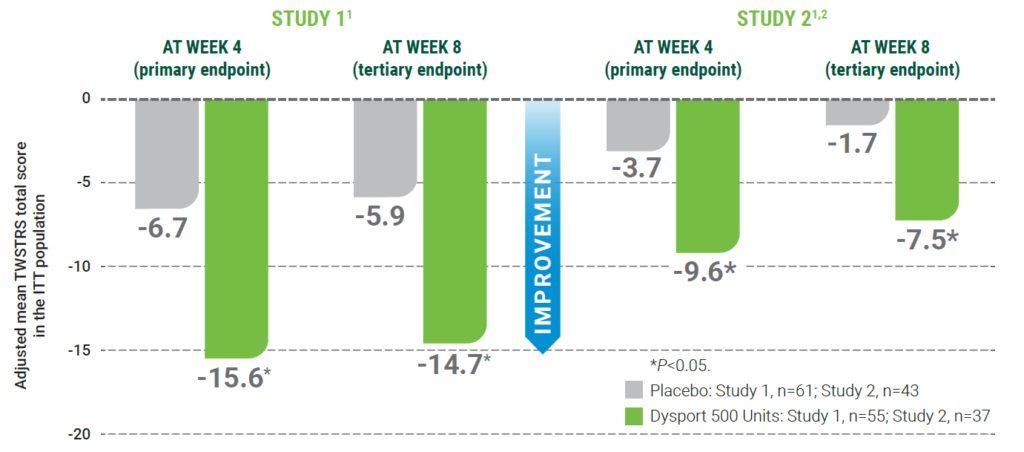ARE YOU A HEALTHCARE PROFESSIONAL?
This site is intended for US healthcare professionals only.
By clicking YES, you attest that you are a healthcare professional licensed in the US.

When stiffness returns too early, the struggle resumes... Use Dysport for symptom* relief that lasts between injections
*Symptoms of cervical dystonia can include abnormal head position and neck pain.


First symptoms or without treatment: “[By the time I was diagnosed,] the symptoms had progressed to a very obvious uncontrollable movement … back and neck pain … Then the pain got worse from the constant muscle spasms….”
With Dysport treatment “I feel sustained between injections up to the 12 weeks.… [Dysport] has lived up to my expectations … it has been a reliable, effective treatment—it’s comforting to know that I can count on [it] to work for me.”
Duration of FDA approval is not intended to imply superiority in efficacy or safety of Dysport
*Primary endpoint, total Toronto Western Spasmodic Torticollis Rating Scale [TWSTRS] change
The median time for retreatment in the clinical studies was 14 weeks and 25% of patients had a time to retreatment of at least 18 weeks.
Dysport is FDA approved for the treatment of spasticity in patients aged 2 years and older, and cervical dystonia in adults.
The efficacy of Dysport was evaluated in 2 randomized, double-blind, placebo-controlled, multicenter, parallel-group, single-dose studies with a 12-week follow-up in 252 patients with cervical dystonia (Dysport, n=121; placebo, n=131).
Patients could switch to open-label extension studies after week 4. Dysport 500 Units was given by intramuscular injection, divided among 2 to 4 affected muscles.

TWSTRS=Toronto Western Spasmodic Torticollis Rating Scale.
At week 4, adults receiving Dysport had a significant reduction in abnormal head positioning vs placebo in 2 studies, as measured by the TWSTRS total score1,2
Most commonly observed adverse reactions (≥5% of patients) were muscular weakness, dysphagia, dry mouth, injection site discomfort, fatigue, headache, musculoskeletal pain, dysphonia, injection site pain, and eye disorders

*Primary endpoint, total Toronto Western Spasmodic Torticollis Rating Scale [TWSTRS] change
†Defined as not previously treated with a botulinum toxin for the treatment of cervical dystonia.
Proven Efficacy

VAS=visual analog scale.
On a 100-point scale (0 [no symptoms] to 100 mm [worst possible symptoms]), baseline VAS score (patient self-rated) was 48.6 in the Dysport group and 52.9 in the placebo group.
Pain Relief
Use Dysport for symptoms relief that lasts between injections — because a long duration of response should matter
For most patients, Dysport provides improvement in range of motion that lasts beyond the minimum retreatment time of 12 weeks (N=108)1,2

Time to retreatment was not a primary endpoint. Repeat Dysport treatment should be administered no sooner than 12 weeks after the previous injection
Study 1 and Study 2 were followed by long-term, open-label extensions that allowed titration in 250-Unit steps to doses in a range of 250 to 1000 Units, after the initial dose of 500 Units. In the extension studies, retreatment was determined by clinical need after a minimum of 12 weeks
The median time to retreatment was 14 weeks and 18 weeks for the 75th percentile
Time to Retreatment
Register for Doctor Locator when you sign up for C.L.I.M.B.®
See eligibility criteria at www.CLIMB-training.com
Register
Postmarketing reports indicate that the effects of Dysport and all botulinum toxin products may spread from the area of injection to produce symptoms consistent with botulinum toxin effects. These may include asthenia, generalized muscle weakness, diplopia, blurred vision, ptosis, dysphagia, dysphonia, dysarthria, urinary incontinence, and breathing difficulties. These symptoms have been reported hours to weeks after injection. Swallowing and breathing difficulties can be life threatening and there have been reports of death. The risk of symptoms is probably greatest in children treated for spasticity, but symptoms can also occur in adults treated for spasticity and other conditions, particularly in those patients who have underlying conditions that would predispose them to these symptoms. In unapproved uses and in approved indications, cases of spread of effect have been reported at doses comparable to or lower than the maximum recommended total dose.
Dysport is contraindicated in patients with known hypersensitivity to any botulinum toxin products, cow’s milk protein, components in the formulation or infection at the injection site(s). Serious hypersensitivity reactions including anaphylaxis, serum sickness, urticaria, soft tissue edema, and dyspnea have been reported. If such a reaction occurs, discontinue Dysport and institute appropriate medical therapy immediately.
Lack of Interchangeability Between Botulinum Toxin Products
The potency Units of Dysport are specific to the preparation and assay method utilized. They are not interchangeable with other preparations of botulinum toxin products, and, therefore, units of biological activity of Dysport cannot be compared to or converted into units of any other botulinum toxin products assessed with any other specific assay method.
Dysphagia and Breathing Difficulties
Treatment with Dysport and other botulinum toxin products can result in swallowing or breathing difficulties. Patients with pre-existing swallowing or breathing difficulties may be more susceptible to these complications. In most cases, this is a consequence of weakening of muscles in the area of injection that are involved in breathing or swallowing. When distant side effects occur, additional respiratory muscles may be involved. Deaths as a complication of severe dysphagia have been reported after treatment with botulinum toxin. Dysphagia may persist for several weeks, and require use of a feeding tube to maintain adequate nutrition and hydration. Aspiration may result from severe dysphagia and is a particular risk when treating patients in whom swallowing or respiratory function is already compromised. Patients treated with botulinum toxin may require immediate medical attention should they develop problems with swallowing, speech, or respiratory disorders. These reactions can occur within hours to weeks after injection with botulinum toxin.
Pre-existing Neuromuscular Disorders
Individuals with peripheral motor neuropathic diseases, amyotrophic lateral sclerosis, or neuromuscular junction disorders (e.g., myasthenia gravis or Lambert-Eaton syndrome) should be monitored particularly closely when given botulinum toxin. Patients with neuromuscular disorders may be at increased risk of clinically significant effects including severe dysphagia and respiratory compromise from typical doses of Dysport.
Human Albumin and Transmission of Viral Diseases
This product contains albumin, a derivative of human blood. Based on effective donor screening and product manufacturing processes, it carries an extremely remote risk for transmission of viral diseases and variant Creutzfeldt-Jakob disease (vCJD). There is a theoretical risk for transmission of Creutzfeldt-Jakob disease (CJD), but if that risk actually exists, the risk of transmission would also be considered extremely remote. No cases of transmission of viral diseases, CJD, or vCJD have ever been identified for licensed albumin or albumin contained in other licensed products.
Intradermal Immune Reaction
The possibility of an immune reaction when injected intradermally is unknown. The safety of Dysport for the treatment of hyperhidrosis has not been established. Dysport is approved only for intramuscular injection.
Adults with lower limb spasticity (≥5%): falls, muscular weakness, and pain in extremity and with upper limb spasticity (≥4%): muscular weakness.
Pediatric patients with lower limb spasticity (≥10%): nasopharyngitis, cough and pyrexia and with upper limb spasticity (≥10%): upper respiratory tract infection and pharyngitis.
Adults with cervical dystonia (≥5%): muscular weakness, dysphagia, dry mouth, injection site discomfort, fatigue, headache, musculoskeletal pain, dysphonia, injection site pain, and eye disorders.
Co-administration of Dysport and aminoglycosides or other agents interfering with neuromuscular transmission (e.g., curare-like agents), or muscle relaxants, should be observed closely because the effect of botulinum toxin may be potentiated. Use of anticholinergic drugs after administration of Dysport may potentiate systemic anticholinergic effects, such as blurred vision. The effect of administering different botulinum neurotoxins at the same time or within several months of each other is unknown. Excessive weakness may be exacerbated by another administration of botulinum toxin prior to the resolution of the effects of a previously administered botulinum toxin. Excessive weakness may also be exaggerated by administration of a muscle relaxant before or after administration of Dysport.
There are no adequate and well-controlled studies in pregnant women. Dysport should be used during pregnancy only if the potential benefit justifies the potential risk to the fetus. Based on animal data, Dysport may cause fetal harm.
The safety and effectiveness of Dysport injected into proximal muscles of the lower limb for the treatment of spasticity in pediatric patients has not been established. Based on animal data Dysport may cause atrophy of injected and adjacent muscles; decreased bone growth, length, and mineral content; delayed sexual maturation; and decreased fertility.
In general, elderly patients should be observed to evaluate their tolerability of Dysport, due to the greater frequency of concomitant disease and other drug therapy. Subjects aged 65 years and over who were treated with Dysport for lower limb spasticity reported a greater percentage of fall and asthenia as compared to those younger (10% vs. 6% and 4% vs. 2%, respectively).
To report SUSPECTED ADVERSE REACTIONS or product complaints, contact Ipsen at 1-855-463-5127. You may also report SUSPECTED ADVERSE REACTIONS to the FDA at 1-800-FDA-1088 or www.fda.gov/medwatch.
Dysport® (abobotulinumtoxinA) for injection is indicated for the treatment of:
Please see full Prescribing Information, including Boxed Warning and Medication Guide.